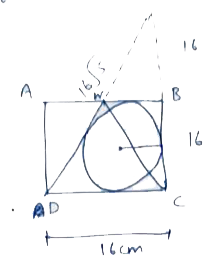ABCD is a square of side 4 cm. +16 esu, −16 esu and +32 esu charges are placed at the points A, C and D respectively. Determine the resultant intensity at B.
The correct Answer is:√3 dyn ; making angle tan−1.√2+1√2−1 with the side BC
Topper's Solved these Questions
- ELECTRIC FIELDBOOK - CHHAYA PUBLICATIONCHAPTER - ELECTRIC FIELDEXERCISE - ENTRACNCE CORNER (ASSERTION-REASON TYPE )
5 Videos
- ELECTRIC FIELDBOOK - CHHAYA PUBLICATIONCHAPTER - ELECTRIC FIELDEXERCISE - ENTRACNCE CORNER (MULTIPLE CORRECT ANSWER TYPE )
10 Videos
- ELECTRIC FIELDBOOK - CHHAYA PUBLICATIONCHAPTER - ELECTRIC FIELDEXERCISE - EXERCISE (PROBLEM SET -II)
19 Videos
- ELECTRIC ENERGY AND POWERBOOK - CHHAYA PUBLICATIONCHAPTER - ELECTRIC ENERGY AND POWEREXERCISE - CBSE SCANNER
7 Videos
- ELECTRIC POTENTIAL BOOK - CHHAYA PUBLICATIONCHAPTER - ELECTRIC POTENTIAL EXERCISE - CBSE Scanner
13 Videos
Similar Questions
ABCD is a square of side 4 cm. Charges of 16×10−9C,−16×10−9C and 32×10−9C are placed at the points A, C and D, respectively. Determine the electric field at point B.
View SolutionFour charges of +q, +q +q and +q are placed at the corners A, B, C and D of s square. The resultant force on the charge at D
View Solution
Knowledge Check
PQRS is a square with side 10 cm. A, B, C and D are mid-points of PQ, QR, RS and SP respectively. Then the perimeter of the square ABCD so formed is
A10√2cmB20√2cmC25√2cmD15√2cmABC is a right angle triangle AB = 3 cm, BC = 4 cm charge +15, +12, -12 esu are placed at A, B and C respectively. The magnitude of the force experienced by the charge at B in dyne is -
A125B35C22D0Equal charges q are placed at the three corners B, C, D of a square ABCD of side a. The potential at A is
A14πε0qaB3q4πε0Cq4πε0a[2+1√2]Dq4πε0a[1+√2]
charges of 20nC each are placed at the corners A and B of a square ABCD of side √8cm and charges of −10nC at the corners C and D. find the potential at the centre of the square.
View SolutionABCD is a square . W is the mid point of AB side of square is 16 cm. Find the radius of circle in figure

View SolutionTwo point charges of +16μCand−9μC are placed 8 cm apart in air. Determine the position of the point at which the resultant electric field is zero.
View SolutionTwo point charges of +16μCand−9μC are placed 8 cm apart in air. Determine the position of the point at which the resultant electric field is zero.
View SolutionEqual charges q are placed at the three corners B, C, D of a square ABCD of side 'a'. The ratio of potential at A to centre O is
View Solution
